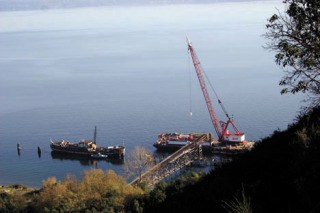After five years of creating both a navigational and ecological hazard, the 180-foot Cactus Jack — a former U.S. Coast Guard buoy tender illegally moored off the shores of Maury Island — has been seized by King County and towed to a private marina.
The black, steel-hulled ship, piled high with rusting appliances, wood scraps and junk, has been tied to dolphins next to Glacier Northwest’s old pier on the eastern rim of Maury since October 2003, when Tacoma officials forced its move from the Thea Foss Waterway.
King County’s Department of Development and Environmental Services (DDES) removed it two weeks ago, days after Glacier began demolishing its old pier and prepping the site for the construction of a new barge-loading facility.
Because of a lack of funds to handle the derelict ship, the county ultimately turned to Glacier to pay for the towing, said Randy Sandin, DDES’s land-use services division director.
“Because of the county’s financial problems, we didn’t have a lot of money to do this,” he said.
Sandin wouldn’t say where the ship now sits. Its owner, David Thomsen, has filed a $125 million lawsuit against the county for the ship’s seizure, Sandin said, noting that he’s hesitant, as a result, to reveal its location.
The county is now working with the state Department of Natural Resources (DNR) to determine the next steps in the expensive and complex process of getting rid of the ship’s contents and ultimately dismantling it.
“There are hazardous materials that have to be addressed and an assortment of debris stored on the vessel,” Sandin said. “That was part of the agreement (with DNR) — to parse out who does what.”
Concern about the Cactus has been mounting over the years, and many have been lobbying for its removal. The “floating junkyard,” as some have dubbed it, has sat directly over prime eelgrass beds — shading out the underwater forests that harbor juvenile salmon, herring and other important fish species — and its impact has been injurious, said Amy Carey, with Preserve Our Islands (POI).
Indeed, she said she’s frustrated that it was finally moved only after Glacier’s construction project forced the issue. POI has long been concerned about the relationship between Glacier and DNR, which just awarded the mining corporation a 30-year lease to state-owned aquatic lands so that Glacier can build its new barge-loading facility.
“This community has been trying to get DNR to move it for years,” she said. “It just brings the question right back around. The day Glacier wanted it moved, DNR was ready.”
But Pete Stoltz, Glacier’s permit coordinator, said his company, too, has been pushing to get the vessel moved for years, ever since it showed up, unannounced, next to Glacier’s old pier. The situation has grown worse in recent weeks, because one of the dolphins it was tied to broke off.
“We were very concerned it could swing into the eelgrass beds or into the beach,” he said.
The county has been working on the ship’s removal for some time, Sandin said. Under legislation passed in 2003, the state created a derelict vessel removal program charged with ranking the vessels in need of removal and working with local agencies to get owners to take care of them or pull them onshore to be dismantled.
The Cactus made it onto the state’s short list, but even at that, Sandin said, it was a time-consuming process. The county had to climb aboard the ship and post a 30-day notice that it would seize the vessel. It then had to find a place to take it until it gets sold or dismantled. What’s more, he said, this is the first abandoned ship King County has dealt with since the state put in place its derelict vessel removal program.
“It’s been a learning experience for all of us,” Sandin said.
The Cactus, built in 1941 in Duluth, Minn., was the first of 39 seagoing buoy tenders made in the 1940s and used extensively during World War II. It was decommissioned in 1971 and sold two years later.
It’s not clear how it ended up in Thomsen’s possession. Now missing its engine, the Cactus required a main tug and another vessel to assist to get it across the Sound and into a marina, Stoltz said.
“We were happy to help the agencies move the vessel to a safer mooring,” he said.



